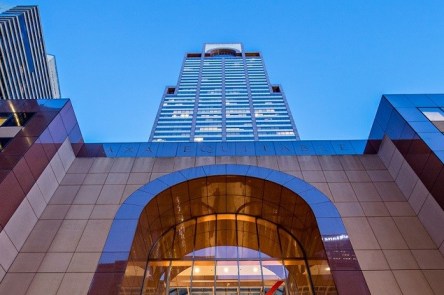The U.S. commercial real estate market took something of a respite in 2016, during a year characterized by political volatility. Compared to the previous year, when the market fired on all cylinders, office players were more cautious in 2016, with leasing and sales activity cooling down to more sustainable levels, per most industry reports. Office tenants were reluctant to make any major moves pending the conclusion of the presidential election, thus lease renewals and consolidations took the stage in the past year. Though office sales activity also decreased 7% year-over-year, according to Colliers, the national transaction volume was still the fourth-highest yearly total in the past 15 years, reaching $140.5 billion. We enlisted the help of Yardi Matrix sales data to round up a list of the 50 largest office deals of 2016. The results of our analysis aren’t all that surprising: the New York City office investment market remains the most attractive destination for both local and offshore buyers, though other markets also landed a good deal of capital in the past year. The U.S. office market is poised to become even more attractive in the future, especially to foreign investors, if Brexit goes through. Check out the list of the top 50 largest office deals of 2016 on the CommercialCafe blog. NYC Home to Largest Single-Asset Sale of the Year The priciest office transaction in New York City and the second-largest overall office deal of the year was the $1.93 billion sale of the AXA Equitable Center at 787 Seventh Avenue in Manhattan. One of the biggest investments in pension fund CalPERS’ history, the sale closed Jan. 27, 2016, at $1,179 per square foot. The 51-story, 1.6 million-square-foot tower is LEED certified and includes 49,000 square feet of retail space, a parking garage and access to the underground concourse of Rockefeller Center. CalPERS bought the...
2016 Recap
Reflecting & Looking Ahead
As 2016 comes to a close, we look back in reflection on a successful year. Here are a few of our favorite Yardi moments from 2016: The Balance Sheet, Yardi’s corporate blog, celebrated its fourth anniversary! In February, Yardi launched a new data centre in Dubai to meet the data security and infrastructure needs of a growing client base in the Middle East. Yardi welcomed iMS Immobilien Management System GmbH to the Yardi family! iMS GmbH is a German developer of commercial property management software. CSU Channel Islands and Pacific Coast Business Times honored Yardi Systems and CEO Anant Yardi. Anant Yardi was named Business Leader of the Year by the Business & Technology Partnership at California State University, Channel Islands. Mr. Yardi was also inducted into the Pacific Coast Business Times Business Hall of Fame in recognition of his contributions to the software industry. Yardi aided displaced Fort McMurray fire evacuees. Mobilizing teams in four different time zones, Yardi created a centralized housing registry connecting local landlords and residents in need of housing. Yardi acquired Proliphix, a leading provider of energy control solutions. We welcomed its clients and staff to the Yardi family! Gordon Morrell was named Executive of the Year at the South Coast Business & Technology Awards. “I’m honored to receive this award, but it really is not for me,” Morrell said. “It is for the entire global team at Yardi. The reason for our success is the exceptional collaboration of everyone at the company, rather than the efforts of one individual.” Yardi won a NREI/IMN Commercial Real Estate Award in recognition of the Yardi®Smart Energy Suite. Multi-Housing News earned Gold for best website at NAREE’s fiftieth conference. In August, we celebrated 5,000 Yardi employees strong worldwide! Yardi released Yardi Genesis2for Affordable Housing. Yardi welcomed two new Marketing Geniuses. Meet Mia...
2016 Real Estate Trends
New year brings similar questions
For both the residential and commercial real estate markets, 2015 brought questions. Would interest rates rise? Would Millennials buy? Would the market keep rising, or are we on the verge of another bubble? As the year draws to a close, these questions remain, though the prevailing mood is optimistic. While the overall market continues its upward climb, moderation has taken hold. It’s clear the gains and price inflations of the past 12 months are giving way to gradual increases, better credit scores and (slightly) upward momentum. In October, PricewaterhouseCoopers and the Urban Land Institute (ULI) released their annual Emerging Trends in Real Estate report. With an eye towards predicting anticipated real estate trends for 2016, the report’s authors conducted over 400 interviews and collected almost 1500 responses. Participants included investors, fund managers, brokers and consultants. The report’s overall mood? Cautious optimism. “You can never forget about cycles,” declares the report, “but the next 24 months look doggone good for real estate.” Commercial Uprising For the commercial real estate market, positive employment numbers are spurring demand for business centers and high-rises. In New York City, for example, over 9.7 million square feet of office space will be added in the next year – an increase unseen in the city for over two decades. The ULI report authors believe that many of these new commercial spaces will include innovative, modern designs created to lure young, in-demand talent. A combination of “entrepreneurial innovation matched up with industry acceptance,” these buildings will dominate a small, but influential corner of the commercial real estate market, pushing projects and encouraging investment. In order to capitalize on this trend, commercial real estate executives will need to be able to analyze property data, control budgets and make future projections quickly and accurately. With an end-to-end, commercial property management platform like Yardi Voyager Commercial, commercial real estate owners, investors and developers can efficiently manage operation strategies and maneuver funds and resources effectively and profitably. The Rise of the Second City Though New York City and San Francisco are real estate behemoths casting large shadows across their respective coasts, their more humble neighbors will soon steal the spotlight. Deemed “18-hour Cities” in the ULI report, these smaller metropolises are beginning to experience population growth and increased commercial real estate investment – a trend the report anticipates will only grow stronger in the coming year. Hot markets like Austin, Denver or Charlotte, along with mid-sized townships sitting along the borders of Dallas, Atlanta and Seattle, can trace much of this commercial activity to the addition of “round-the-clock” businesses. Restaurants, shops and other professional services are beginning to expand their hours of operation from the standard 12 to 18 or more. For potential residents, access to all the amenities of a larger metropolis like New York City at a more affordable price is attractive. The ability to strategically market to disaffected city-dwellers will be essential to capitalizing on this migration trend. One way real estate professionals, property owners and managers can take advantage of renewed interest in their area is to leverage dynamic, multi-channel marketing with tools like those offered by RENTCafe®. With the RENT Café®, users will be able to entice prospects and retain current residents with marketing campaigns precisely fashioned to highlight the benefits of moving to these up-and-coming second cities. Slice of the Suburbs With all the excitement surrounding the urban real estate market, you’d think the suburbs would be slowly fading into oblivion. Instead, multitudes of Millennials are migrating to the outskirts of town. As this generation finally ages into marriage and family, many of those young urban hipsters will soon be trading in their rented lofts for suburban homesteads. They won’t just be embracing the dream of the white picket fence. These young home buyers will be following the job market. Almost 85% of new employment opportunities continue to be “located outside the center-city core” according...



